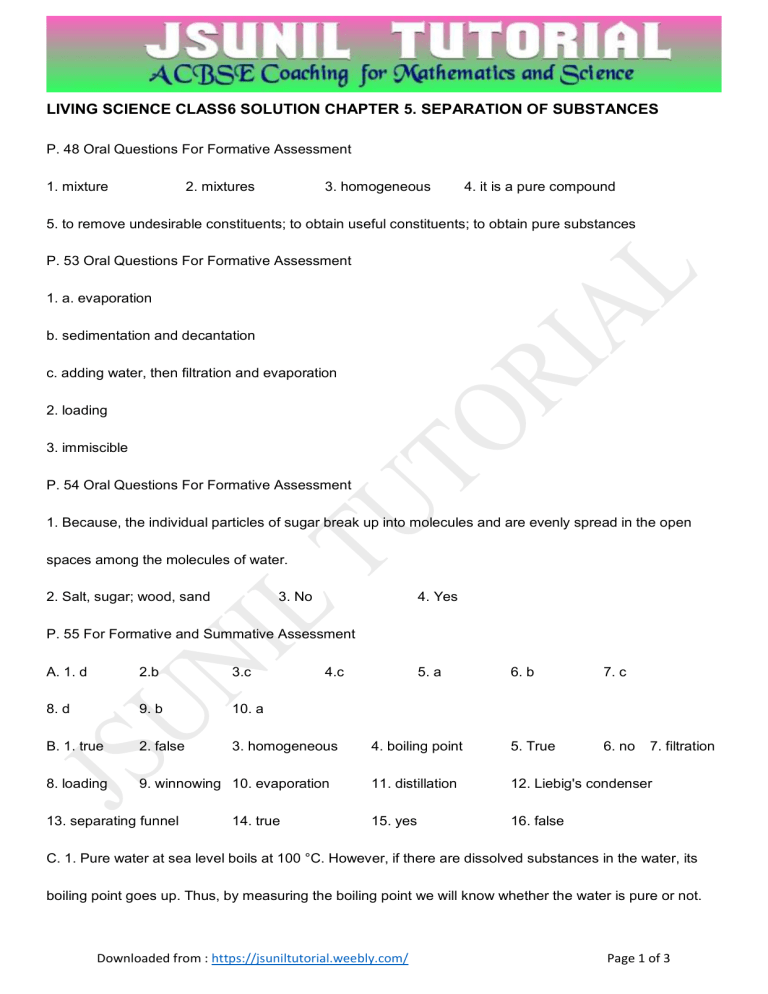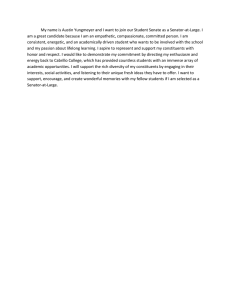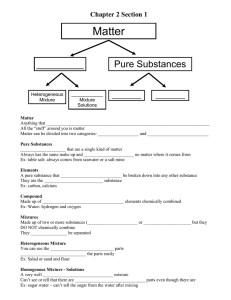
LIVING SCIENCE CLASS6 SOLUTION CHAPTER 5. SEPARATION OF SUBSTANCES
P. 48 Oral Questions For Formative Assessment
1. mixture 2. mixtures 3. homogeneous 4. it is a pure compound
5. to remove undesirable constituents; to obtain useful constituents; to obtain pure substances
P. 53 Oral Questions For Formative Assessment
1. a. evaporation b. sedimentation and decantation c. adding water, then filtration and evaporation
2. loading
3. immiscible
P. 54 Oral Questions For Formative Assessment
1. Because, the individual particles of sugar break up into molecules and are evenly spread in the open spaces among the molecules of water.
4. Yes 2. Salt, sugar; wood, sand 3. No
P. 55 For Formative and Summative Assessment
4.c A. 1. d
8. d
2.b
9. b
3.c
10. a
5. a 6. b 7. c
B. 1. true 2. false 3. homogeneous 4. boiling point
8. loading 9. winnowing 10. evaporation 11. distillation
13. separating funnel 14. true 15. yes
5. True 6. no 7. filtration
12. Liebig's condenser
16. false
C. 1. Pure water at sea level boils at 100 °C. However, if there are dissolved substances in the water, its boiling point goes up. Thus, by measuring the boiling point we will know whether the water is pure or not.
Downloaded from : https://jsuniltutorial.weebly.com/ Page 1 of 3
2. To separate a mixture into its constituents we have to use some property that one constituent has while the others do not have.
3. The size of the holes of the sieve should be bigger than the size of sand particles and smaller than the size of rice seeds.
4. The filter paper has fine holes which allow a liquid to flow through, but not the particles of an insoluble solid. This helps it to separate the insoluble solid from the liquid.
5. The temperature of a saturated solution is specified because the solubility of most substances increases with temperature.
6. Handpicking can be used to separate the constituents of a mixture only when the particles of the undesirable substance have different colour, shape and size and are present in small quantities.
7. Objects at a distance are seen more clearly after rain as loading of dust particles in air takes place when it rains. The dust particles become heavier and settle on the ground.
8. To load means to make it heavier. In loading, the fine suspended particles are made heavier to make them settle down.
D. 1. The constituents of a homogeneous mixture cannot be seen separately, for example, sugar in water, whereas the constituents of a heterogeneous mixture can be seen separately, for example, chalk powder in water.
2. The three properties of mixtures are (i) The constituents of a mixture may be in any ratio. (ii) The constituents retain their individual properties. (iii) The constituents can be separated by simple methods.
3. (i) To remove undesirable constituents for example, harmful substances present in river water.
(ii) To obtain useful constituents for example, butter can be obtained from milk or curd by churning it.
4. See diagram
5. See diagram
Downloaded from : https://jsuniltutorial.weebly.com/ Page 2 of 3
6. First of all we remove pebbles by hand pocking. Grass can be separated by filtration and sand can be separated by sedimentation and decantation.
7. Pour oil and water in a separating funnel and let it stand for some time. You can clearly see two layers - water at the bottom and oil on top. Carefully turn the stopper of the funnel and allow the water to flow out into a beaker placed below the funnel. Stop the flow as soon as the layer of oil reaches the stopper.
8. In the process of digestion, food is reduced to simple substances that are soluble in water. They can then be dissolved in water and absorbed by the body several waste materials produced in the body are dissolved in water and excreted. A number of chemical reactions occur inside our body they all occur in the presence of water. Plants can absorb nutrients from the soil °nil if they are soluble in water Minerals from the roots and food from the leaves are transported to different parts of the plant in the form of solutions in water.
HOTS Questions
1. By mixing a small amount of it with water - salt will dissolve in water whereas chalk will not.
2. Filter the mixture. The residue on the filter paper will be a mixture of sand and iron filings. Dry the residue and roll a magnet in it - the iron filings will stick to the magnet and get separated. The filtrate will be a solution of salt and water. Use distillation to get pure water. The salt will be left behind after all water has evaporated.
3. No change
4. Yes, the solubility of sugar water reduces with decrease in temperature. Therefore when the temperature is powered, some sugar will separate out but the solution will continue to be saturated
5. Because It is an expensive method.
Downloaded from : https://jsuniltutorial.weebly.com/ Page 3 of 3



